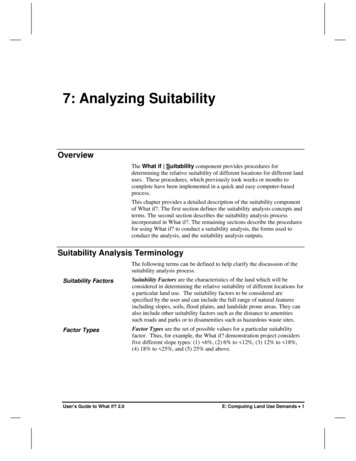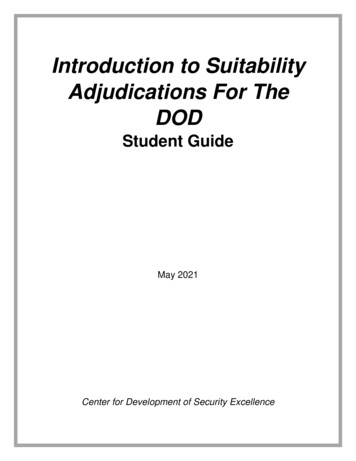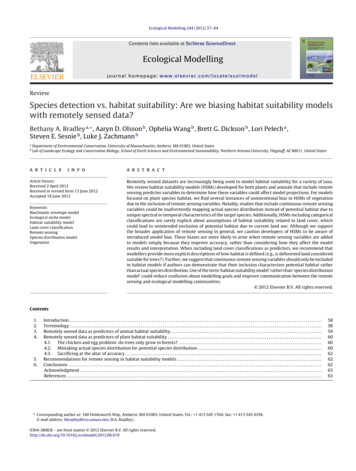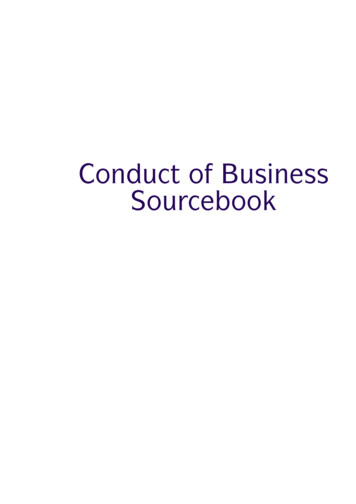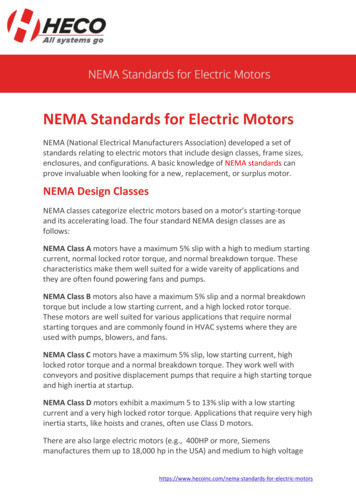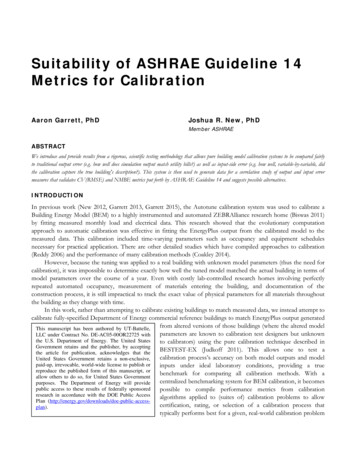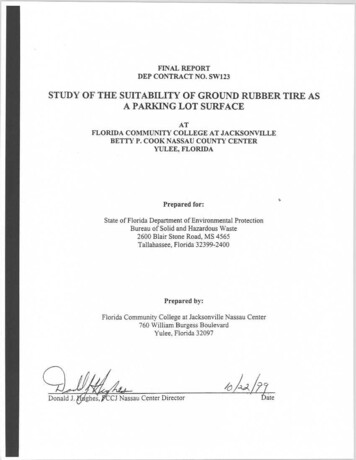
Transcription
I.PROJECT OVERVIEWThis document will summarize a study conducted by the State of Florida Departmen1:ofEnvironmental Protection (DEP)-Bureau of Solid and Hazardous Waste in contract with FloJridaCommunity College at Jacksonville (FCCJ). The study, conducted over a three-year period,investigated the environmental impact and practicality of using ground rubber vehicle tires as aparking lot surface at the FCCJ Nassau Outdoor Education Center in Yulee, Florida.Site and LocationThe FCCJ Betty P. Cook Nassau County Center consists of 43 acres of property. It c:anbe reached by traveling north from Jacksonville, Florida on Interstate 95 to Exit 129. Exit 1:Z9islocated eight mi}es north of the Jacksonville International Airport. William Burgess Boulevard,the entrance road to the college, is located on the south side of AlA east of195, one-half milefrom Exit 129. The FCCJ Nassau Center is located 1.2 miles on the right as you travel south onWilliam Burgess Boulevard. The Outdoor Education Center is the second entrance on the righthand side of the road.Approximately 16 acres of the FCCl property is designated as the Outdoor EduCfltionCenter. The buildings at the Outdoor Center are renovated portable classrooms and cargoshipping containers. The renovations and adaptations to the buildings include cedar siding,raised wooden walkways between buildings, and exterior porches. The Outdoor Center offersoutdoor-related recreational courses, a low-ropes course, and workshops and classes on teambuilding, problem-solving, communication, and creativity. The facilities are also utilized bycommunity groups for meetings and retreats. A layout of the buildings can be found inAppendix A -General Site Plan.The wooded cover of the site nestles the small cedarbuildings to create a peaceful andrelaxing ambiance. Unfortunately, the site was disturbed during hot, dry, days by traffic enteringthe dirt parking areas and internal roadways creating dust and sometimes disturbing the outsideactivities and learning experiences that were taking place.Florida Community College at Jacksonville eagerly pursued the opportunity to contr:actwith the State of Florida DEP to conduct an experiment to test the environmental impact andpracticality of using ground rubber tire to cover the dirt parking areas and internal roadways.FCCJ wanted to resolve the dust issue but did not intend to pave the areas in question becauseofthe environmental restrictions and becauseof the negative impact on the ambiance. Theopportunity to use the Outdoor Center parking/roadways as a test site for the use of ground tiresappealed to the college as it helped maintain the aestheticsand reduce the dust problem. Theneed of FCCJ and the desire of the DEP to find uses for recycled tire material led to Contrac:tSW123 that is summarized in this report.1
Contract SW123Contract SW123, which outlines the steps that were to be taken in the study, wasexecuted in June 1995. The contract was completed in August 1998. Although the contract wasdesigned to conclude in a shorter time period, State budget restrictions mandated that the projectbe put on hold for a time and then restarted. This chronology is documented in Section IIIQfthisreport.Project IntentThe project was designed to test the practicality and use of ground tires as a material tosurface parking areas. It included assessingthe environmental impact-that the recycled tiresurface would have on the soil, groundwater, and stonn water. Baseline data was establisbledandregular monitoring and testing of the site was conducted over a period of time. The timing of themonitoring varied at times due to the lack of rainfall. Rainfall was necessary in order to collectsamples.Project StepsGuidelinesfor the projectrequiredseveralstepsincluding a PlanningPhase ThS1Phase.a :E1.:eldPLANNING PHASE1. Prepare a topographical site plan.2. Determine the flow of surface water.3. Determine sampling points for rainwater prior to ground contact,storm water in various contact stages,and groundwater in various contactstages.4. Describe all potable wells within 0.5 miles of the test site.5. Design storm water sampling points.6. Submit an approved Quality Assurance/Quality Control (QAlQC) project plan.FIELD TEST PHASE1.2.3.4.5.6.Install rain gauge sampling point.Construct three storm water-sampling points.Construct and develop four groundwater-sampling points.Sample as directed after rain event.Analyze all samples in a timely manner for specified elements.Install ground rubber tire on 39,000 square feet of parking and driveway to athickness of 3-4 inches.7. Repeat sample collection and analysis on a periodic basis. .8. Submit appropriate formative and summative reports.2
Please refer to Appendix B -Scope of Services, for com lete detailed steps for Planning andField Phasesof the study.ResultsThe project, although delayed as previously noted, was successfully concluded in Augustof 1998. The results, including the practicality of use and the environmental impact, wereprimarily positive with very little impact on the soils and water that was tested. A completesummary of the environmental impact can be found in Appendix C -Final Report Groundwater,Rainwater, Surface Runoff, and Soil Quality Investigation. Practicality issues are addressedinSection IV.II.Chronology of Major Project ActivitiesThe following chronology summarizes the major activities that occurred in fulfilling: theconditions ofDEP Contract No. SW123. Although self-explanatory, there were a few obstaclesencountered.State funding for the project was withdrawn in December of 1995 due to State fiscalconcerns. This resulted in suspending the project until the fiscal concerns were remedied. .I tthat time, the physical requirements to monitor the project were in place (rain gauge,groundwater-monitoring wells, and stormwater monitoring devices) and a baseline sample andreport had been submitted. The railroad tie "curbs", to contain the PermaPark material, and thePermaPark had also been installed.The fiscal issuesresulted in no activity on the project for approximately 18 months. Anew vendor, Aerostar Environmental, Inc., was selected by Florida Community College atJacksonville to complete the project as RSDI Environmental, Inc. was unwilling to continue: theproject within the allowed budget. The number of sampling events was adjusted to meet thc budget and necessarytime frame for completion. These changes are noted in the contractamendments.March 1995Draft proposal for an "Environmental Impact Study of Waste Tire Shredsas a Parking Lot Surface" developed. See Appendix D.March 1995PemlaParkrubbersurfacingselectedassurfacefor proposedproject. SeeAppendixE.May 1995Florida CommunityCollege at JacksonvilleBoard of TrusteesapprovesProject.3
June 1995Department of Environmental Protection Contract No. SW123 enterledinto by DEP and FCCJ.July 1995FCCJ enters contract with RSDI Environmental, Inc., to installmonitoring equipment and to conduct sampling and testing in accordancewith DEP approved Quality Assurance Project Plan (QAPP).August 1995RSDI, Environmental,Inc. QAPPplan approvedby DEP.August 1995Site work completedandtestedfor monitoring and samplingpurposc:s.November 1995Baselinesamplingconducted.Noy.mec.1995Parking area and internal roadway covered with ysubmittedby RSDI Environmental,Inc.December 1995DEP temporarily tenninates project due to State funding restraints.June 1996DEP Contract No. SW123 amended (#1).March 1997FCCJ approves Aerostar Environmental Services, Inc. as the new vendorfor DEP Contract SW123. RSDI, Environmental, Inc. was invited tocontinue project but was unwilling to continue without a substantialincrease to the fees they charged, thus the change to AerostarEnvironmental Services, Inc.April 1997DEP ContractNo. SW123amended(#2).June 1997Project restarted with cleaning and recalibration of monitoring stations.June 3,1997Samplingconducted.July 8, 1997First ProgressReportissued.September 1997Aerostar Environmental Services Quality Assurance Project Planapproved by DEP.December 1997Samplingconducted.January 1998SecondProgressReportissued.June 1998DEP Contract No. SW123 amended (#3).June 1998Samplingconducted.4
July 1998Third Progress Report issued.September1998Final SummaryReportsubmittedby AerostarEnvironmentalServices,Inc.III.Quantitative and Qualitative SummariesQuantitative Summar): -Materials & Test ] A total of 131 tons of PennaPark treated waste tire product was placed on 39,000 sqlLlarefeet of internal roadways and parking lot spacesat the FCCl Nassau Outdoor Education Center(See Appendix A- General Site Plan). The exterior edgesof the roadway and parking areas, withthe exception of ingressesand egresses,were lined with donated CSX railroad ties to create abarrier to keep the material from spreading. The ingressesand egresseswere not lined "'ith therailroad ties becauseof the need for vehicles to travel in and out of the area. The ground swfacecoverage ranged from 2 1/2 to 3 1/2 inches deep, with the lowest concentration being used in theless traveled parking areas and the deepestapplication in the roadways. The materials wereapplied over a natural dirt road. The application of the PennaPark was done with a fann tractorequipped with a front-end bucket. An approximately 4' x 8' wire fence rake, with a woodenweighted cross piece at the back, was constructed to drag behind the tractor to groom thematerial to the desired application depth. This tool is used periodically to groom the materialafter it shifts due to use and/or heavy rains.The materials used to collect the samples and the quantitative study data (in chart fon1l)and implications are best summarized in Appendix C, the Final Report issued by AerostarEnvironmental Services, Inc. The report summarizes the collection methods, dates, andlaboratory analysis of the samples.The four sampling events showed sodium, chromium, iron, total xylenes, and antimonyconcentrations above laboratory detection limits in the groundwater samples collected during thestudy (Table 1 in Appendix C). The groundwater iron concentrations exceededthe FDEPgroundwater guidance concentration of 0.3 mgiL, with high readings from .33 to 1.46. NassauCounty background levels in the shallow aquifer typically range from 0.2 ppm to 0.6 ppm.The four sampling events showed barium, iron, sodium, zinc, chromium, lead, andantimony concentrations above laboratory detection limits in the surface water runoff samgl (Table 2 in Appendix C). The concentrations detected were below surface quality standards;.The four sampling events showed toluene, antimony, chromium, copper, iron, lead, : inc,barium, nickel, sodium, arsenic, selenium, and TRPH concentrations above laboratory detection5
limits in the soil samules collected for the investigation (Table 3 in Appendix C). The de1:ectedconcentrations are below the soil cleanup target levels.Only the iron concentrations detected in the groundwater samples exceeded Stateguidance concentrations. The sampling data on this element fluctuated widely (Table 1 inAppendix C) by sampling site and collection date, with no obvious pattern. It is inconclusivethat this fluctuation was caused by the water runoff from the PermaParkmaterial and/or normalbackground concentrations, or a combination of both.Qualitative Summa The sampling and analysis of the groundwater, stOrnlwater, and soil show evidenc:eofminimal, if somewhat insignificant, contamination due to the installation of the PermaParkrubber tire material. It cannot be assumedthat similar results would occur in other applicationsof recycled tire material.The PennaPark recycled tire product is a high quality product that is almost metal free.Similar material produced from other manufacturers may have slightly different specifica1:ions.Different specifications could drastically increasethe contaminants introduced into theenvironment. Care should be taken, when using recycled tire product, to carefully examine theproduct specifications to insure that the product is of the highest quality possible. Soil quality isanother factor and it is not known, from the results of this study, if different soil compositionwould react differently to the introduction of tire material.The cost of the PennaPark material, at the time of installation, was 185 a ton. One toncovers 300 square feet of surface to a depth of 3". The present cost for the material is 265 a ton,an increase of 43.6% over a three-year period. These figures do not include installation costssuch as containment barriers (we used railroad ties) and the labor and equipment needed tl[)spread and maintain the material. These financial considerations, as well as the environmentaland aesthetic factors, need to be taken into consideration when making a detennination onwhether to use this type of substance for ground cover. The relative return on investment is animportant consideration.The monitoring and testing process that occurred in this project required that thesubcontractors have accessto the site for sample collections and maintenance of groundwaterand storm water collection points. The initial start-up, suspension, then re-start of the projectresulted in changing vendors. The first vendor installed the necessaryequipment and producedthe baseline study and initial QAPP. The project was then suspendeddue to funding issues. Thesecond vendor re-started the project, resubmitted a QAPP and conducted three sampling e:vents.Sampling could only be conducted after significant rainfall during the time framesspecified in the QAPP. This required FCCl to issue accesskeys to the vendors to enable them toenter the property on weekends and holidays when the college is normally closed and gatc d.There were no problems associated with this action.6
Determining the location of the monitoring stations, during the re-start by the newvendor, proved to be an unanticipated difficulty. During the approximately 18 months that theproject was suspended,the natural vegetation at the project site grew and literally covered tIpmany of the monitoring stations. The new vendor, even with monitoring well map in hand, hadsome difficulty locating the stations. The locations were eventually found after clearing brushand using some of the FCCJ staff to assist in the search. Location flags, or some other abo,reground locator should be considered for future projects in natural vegetation areas.The "loss" of material was a phenomena that occurred due to the topography (SeeAppendix F) of the site. The site is naturally sloped to drain to a nearby marsh area. Signij}cantand prolonged rain resulted in the movement of material within the project area and also re )ultedin some of the material being washed out of the project area through the open ingressesand!egresses. I estimate that 10-20% of the material was lost to this phenomena over the duration ofthe project. This will result in a replacement cost and an adjustment to the entrances/exits tocreate a barrier to minimize the losses due to "material erosion". The impact of the material thatdrifted into non-project areaswas not monitored in this project, other than through themonitoring stations.Environmentally, the project data showed that the PermaParkmaterial was a suitable andpermeable ground cover for parking areasand internal roadways that vehicles travel td'reac:hparking areas. A complete discussion and conclusion on the suitability of using the materi ll inparking and driveway areasfollows in Section IV.IV.Discussion/Conclusionsand Suitability for Future InstallationsPracticalitY of UseThe use of the ground rubber tire accomplished the objective of the FCC] NassauOutdoor Education Center. The covering of ground tire over the dirt parking and driveway keptthe dust at a minimum and retained, and may have even enhanced,the ambiance of the setting.The road covering was more often a topic of conversation than it was not when a new group orperson arrived at the Center. The Outdoor Center was developed with many recycled materials(buildings, cargo containers, used furniture, etc.). The utilization of yet another recycledmaterial strengthenedthis theme and prompted many discussions regarding the effective use ofwaste or discarded products.This experiment was designed to field test the material in an application over a dirtsurface in a fairly pristine environment. In addition to the measurable scientific analysis of theimpact of the material on the water and soil it contacted, there were evaluations made in relationto the practicality and maintenance of the material. In this specific application, there wereimportant advantagesand some disadvantages.7
.The advantagesof usingthe PennaPark,in this specific applicationwere:It is aesthetically pleasing, especially in the outdoor education settingIt kept the dust to a minimumIt created a quiet driving surfaceIt is very penneable and, except for deluges, drains quickly thus keeping mud to aminImumThe penneability of the material make it environmentally friendly in tenDSofrainwater and stonn water dissipationBecause of the penneable quality of the material, users are not under therestrictions they would face if installing non-penneable materialIt created a cushioned surface for outdoor activitiesIt didn't noticeably seemto wear in texture nor fade in colorIt is light in weight and easyto handle as opposed to gravelThe disadvantagesof using the PermaParkmaterial in this application were:.,It requires raking and grooming especially following rain storms or after aprolonged period of heavy vehicle trafficRainwater runoff on the gently sloped terrain resulted in the shifting of thematerial, some of which was "lost" in the land adjoining the parking areaProlonged torrential rain, over a period of days, resulted in an incident or tw'owhen the material was washed over the top of the railroad ties used to contain itThe material is not ADA compliant as wheelchair bound individuals cannottraverse it without assistanceIt radiates heat on hot summer daysLeaves and other windblown material tends to collect on this material and canonly be removed by picking it up by handDuring periods of ground saturation, the material slightly floats and exhibits asquishy qualityThe material gave off a petroleum odor for about two months after the initialapplicationOn sloped terrain, the material needs to be contained by some type of barrierThe railroad tie barriers used in this project gave off a creosote odor for the firstcouple of monthsThe railroad tie barrier was several inches higher than the PermaPark whichcreated a safety hazard for all (creating a step-over area) and created anaccessibility issue for wheelchair bound individualsVehicles that travel over 5 mph tend to "pick-up" PermaPark material in theirvehicle frame or undercarriage thus causing unnatural erosion of the productThe product sometimes is carried away on the bottom of shoes8
4.ConclusionsThe application of the PennaPark material to the natural parking and road surface a1ttheFCCJ Outdoor Education Center has been a positive experience that would be repeated ifth choice was given again. The treated area, which primarily consists of parking areas,has beenwell served by the substance. The material, unless it is applied on a flat surface. requires edgebarriers to prevent it from drifting due to heavy rainfall and/or heavy or fast moving traffic.Use of the material without accommodations for wheelchair crossings, etc., possiblyviolates the guidelines established by the ADA regulations. It is almost impossible for anindividual in a wheelchair to traverse the road independently.The use of railroad ties as the containment barrier for the material has proven to beeffective but will eventually create maintenance problems as they deteriorate and need to bc replaced. A less intrusive (height), but more permanent containment barrier, should be explored.Although not done so in this project, containment barriers should be installed around the .e.n project area. This would substantially reduce the loss of product.Adjustments to this site, now that the scientific data has been collected, include erectingsome kind of containment barrier at the entrancesand exits of the parking area to redu&eerosion,and the development of "wheelchair crossings" than can be used independently by individualswho utilize wheelchairs for transport.Suitabili for Future InstallationsThe ground rubber tire, specifically PennaPark, is a viable alternative for a parking :areaas opposed to the application of a pennanent material such as asphalt or concrete. Potentialconsumers need to carefully analyze their needs and issues. Some questions they may wan1:toaddress include:1.2.Is the topography of the land flat or sloped?Will the traffic speed generally be less or more than3Will the physical appearanceof the material enhance or hinder thesite ambiance?Can the cost of the product be justified when compared with 4: ther5 mph?5.6."surfacing" options?Will there be the resourcesavailable (staff & equipment) tomaintain and groom the product at the application site if it drifts?Will there be adequatedistance between the parking area and anentrance to a building in order for material that is carried on thebottom of shoesto falloff before it is tracked inside the building?The use of PennaPark or similar material in parking areasis feasible if the user is capableand willing to maintain it. Short tenD uses for a temporary parking area, or longer-tenn USf:S,such as the project summarized here create excellent opportunities to responsibly recycle w'aste9
tires. Maintenance issues, desired site ambience, and relative cost are the three factors thatanyone considering the material should explore first. Containment of the material is the mostcritical maintenance issue that needs to be addressedbefore deciding to utilize this type ofproduct. The inability to effectively contain the material will result in increased maintenanceand, eventually, refurbishment expenses.In conclusion, this experimental project has been very successful for the host SpoJllsor.The environmental impact has been minimal. The objective for using the material has beenaccomplished. The issues that have surfaced through formative and sumrnative evaluation are allresolvable. The PermaPark, or a similar product, should be considered as an alternative topermanent paving of parking areas when the nature and use of the parking deem it feasible.Conditions that would be favorable to the use of the material include a flat topographical surface,the ability to erect containment barriers, a speed limit of no more than 5 mph, and an appropriatedistance between the parking and buildings to prevent tracking the material into buildings. 10
ADVEIo-.lTUr.:2.EPROGr t:.M,NASSAUCEI-JTER,'FCC':'
DEP ContractSW123SCOPEOF SERVICESSTUDY OF THE SUIT ABll.ITY OF GROUND TIRE RUBBER AS A PARKING LOT SURFACESection403.709 (2)(b), Florida Statutes,(F.S.), authorizesthe FDEP to expendfunds from thewaste tire accountof the Solid Waste ManagementTrust Fund for researchprojects relating to solving.solidwaste problemsresulting from waste tires.This contract with Florida CommunityCollege at Jacksonvilleis to deternlinethe efficac:yandsafetyof using a granulatedwaste tire material for surfacingof a parking lot. Under the proposal, theCollege is responsiblefor the following activities:I.PlanningPhaseA,Prepare a topographical site plan of the FCCJ Outdoor Adventure Cen'terinYulee, Florida which shows:1.The directional flow of surfacewater.2.The proposedlocation of the waste tire material surface.3.The proposedlocationof samplingpoints to sample:a.Rainwaterprior to ground contact.b.Stonnwater that has passedthrough granulatedtire rubbf:r butnot subjectedto fluid leakagefrom vehicles.c.Stonnwater that haspassedthrough granulatedtire rubber andsubjectedto possiblefluid leakagefrom vehicles.d.Stonnwater that has had ground contact but which has notpassedthrough granulatedtire rubbere.Groundwater that has not had contact with granulate ltirerubber.fGroundwaterthat haspassedthrough both soil and granulatedtire rubber but has not been subjectedto fluid leakage fromvehicles.g.Groundwater that has passedthrough both soil and grantllatedtire rubber and has been subjected to possible fluid le.ikagefrom vehicles,h.Groundwaterthat is down gradientfrom the site.4.Potable drinking water wells within 0.5 miles of the test ,site.Occupants of each dwelling within this area will be contacted andaskedto provide the size,depth, and age of their wells,B.Design stonnwatersamplingpoints.C.Submitan approvedQA/QC plan for the project.IIField Test PhaseA.Install eight samplingpoints.1.Rainwatersamplingpoint is a recordingrain gauge.2.Construct three stonnwatersamplingpoints. .3.Construct and develop four groundwater sampling points. Each ofthese sampling points consistsof a 2" diameter monitor well "vith amaximum depth of 15'. Wells will be constructedof schedule40 PVC
H.G.D.DEP ContractSW123Bc.D.E.F.c.flush thread pipe (assembledwithout adhesive)with 5' of .010 slottedscreen. Wells will be filter packed with clean, dry silica sand frombottom of screento 2' above top of screen, then grouted from thatpoint to land surface. After grout has set for a minimum of 12 hours,wells will be developed. Development will be accomplished bypumpingwith a centrifugal pump until water is free of sedimentor for aperiod of time determinedby FDEP representative.Finishedwells willbe protected by a locking cover and set in 2'x2'x4" concretepads.During or immediatelyafter a rain event, collect one set of samplesfrom eachof the samplingpoints, one replicate set from a monitoring well, and two soilsamplesin the area to be covered by tire material. Prepare one set of fieldblanks. All sampleswill be collectedand preservedin accord with the QAlQCplan.Analyze all samplesin a timely mannerfor:1.Total petroleumhydrocarbons(TPH)Method 3500/418.12.Semi-volatileorganicsMethod 82703.Volatile organicsMethod 80204.Metals EPA primary pollutant metals plus iron, excluding TCLPproceduresInstall granulatedtire rubber on 39,000 square feet of parking and drivewayareaand compactthe materialto a thicknessof three to four inches.Restartthe project whenfunds are available.Repeatsamplecollection (B) and analysis(C) at the time of restarting. Submita report comparingthe before and after results.Repeat sample collection (B) and analysis (C) six months after the samplescollected in AF@. Submit a report comparingthe before and one, t11fee,andnine month results.Repeat sample collection (B) and analysis (C) eighteen months after theinstallationof granulatedtire rubber.Submita draft final report within 45 daysof the project's completion which willcontain:1.A chronological descriptionof major project activities, including anyunexpectedobstaclesor observations.Quantitativeand qualitative summariesof the analytical data, including2discussionof the environmentalimpactof the project.3.Discussion and conclusions regarding the physical suitability ofgranulatedtire rubbermaterial in parking lot and driveway applicationsand anyrecommendationsto improve future installations.Submit a final report. At least one copy of the final report will be bound andone copy will be one sidedand un-boundwith no holes or staples.
/-!FINAL REPORTGROUNDWATER, RAIN WATER, SURFACE RUNOFF,AND SOIL QUALITY INVESTIGATIONFCCJ-NASSAU CENTERYULEE, FLORIDAPrepared For:Florida Community College at Jacksonville501 West State StreetJacksonville, Florida 32202-4030Prepared By:AerostarEnvironmentalServices,Inc.11200-1St. JohnsIndustrial ParkwayJacksonville,Florida 32246/7,,-.-'.?Leon J. Catr'ero, te
TABLE!TABLE OF CONTENTS1.0 EXECUTIVE SUMMARY.2.0 INTRODUCTION.23.0 SAMPLE COLLECTION AND LABORATORY ANALYSES."34.0 RESULTS OF LABORATORY ANALYSES55.0 CONCLUSIONS.6TABLESTABLE2TABLE 3Summary of Rain Collection and Groundwater AnalysesSummary of Surface Water Collection AnalysesSummary of Soil Laboratory AnalysesFIGURESFIGURElFIGURE 2F:\FCCJ.FIN.wpdSite Location MapSite Plan
FINAL REPORTGROUNDWATER, RAIN WATER, SURFACE WATER RUNOFF,AND SOIL QUALITY INVESTIGA nONFCCj.NASSAU CENTERYULEE, FLORIDA1.0 EXECUTIVE SUMMARYAerostar Environmental Services, Inc. (AEROST AR) has completed the bi-annual sampling andlaboratory analysesevents as part of the feasibility study of the suitability of granulated tire rubberas a parking lot surface material for the Florida Community College at Jacksonville (FCCJ)-BettyP. Cook Nassau County Center located in Yulee, Florida, hereinafter referred to as the site.Groundwater, surface water runoff, rain water, and soil sampling was conducted on June 3, 1997,December 3, 1997, and June 24, 1998 by AEROST AR personnel. The sampling was conducted inaccordance with the Comprehensive Quality Assurance Project Plan (CompQAPP) number940023G, approved by the Florida Department of Environmental Protection (FDEP) and therequirements specified by FCCJ in the Scopeof Services-Studyof Suitability of Ground Tire RubberAs A Parking Lot Surface Material. Four groundwater samples (including an equipment blank anda duplicate blank), three surface water runoff samples, one rain water sample, and soil samples(collected directly beneath the rubber tire material) were submitted for laboratory analyses. Thesamples were analyzed for Total Recoverable Petroleum Hydrocarbons (TRPH) by the FL-PROMethod, and the parameterslisted in EPA Method 8270 for Semi-Volatile Organics, EPA Method8020 for Volatile Organics, EPA 13 Priority Pollutant Metals, barium, sodium, and iron. Sampleswere also collected in November 1995 by a previous consultant as part of the feasibility study. Theresults of the sampling events are summarized in this report.Except for the iron concentrations detected in groundwater samples collected from MW-l. MW-3.and MW -4. all re
The four sampling events showed toluene, antimony, chromium, copper, iron, lead, : inc, barium, nickel, sodium, arsenic, selenium, and TRPH concentrations above laboratory detection 5. . Qualitative Summa The sampling and analysis of the groundwater, stOrnl water, and soil show evidenc:e of minimal, if somewhat insignificant, contamination .


